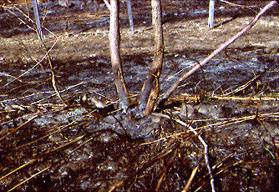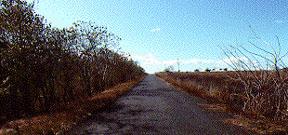�

Forest fires may be gaining new respect
in the Western United States, but not along the Pacific coast of Costa Rica. Here, in a remnant of vanishing dry tropical forest (defined), wildfires are the problem, not the solution.
The explanation is pretty simple, according to Daniel Janzen, a biologist with the University of Pennsylvania who serves as a scientific advisor to Guanacaste Conservation Area. In this part of Costa Rica, there are no summer thunderstorms. Thus there was no lightning to cause natural fires, meaning the forest evolved without fire.
But when the Spanish settled the area in the late 1500s, farmers and ranchers began using fire to clear their fields. And since then, the dry tropical forest along the Pacific coast has been burning and shrinking. In Guanacaste Conservation Area, for example, intense winds fan the fires, which can burn unchecked from the continental divide (defined) to the Pacific Coast.
 These trees were killed by a fire that is paving the way for a vigorous grass that continues to crowd out scraps of dry forest along the Pacific coast of Costa Rica. Unless stopped, these fires will destroy one of the last remaining examples of tropical dry forest. All Costa Rica images © David Tenenbaum.
These trees were killed by a fire that is paving the way for a vigorous grass that continues to crowd out scraps of dry forest along the Pacific coast of Costa Rica. Unless stopped, these fires will destroy one of the last remaining examples of tropical dry forest. All Costa Rica images © David Tenenbaum.
This forest once stretched along the Pacific from the Isthmus of Panama to Central Mexico, Janzen said, and it's now been cut back to as little as 1,000 hectares (2,500 acres) mainly due to the encroachment of farms, ranches and cities.
"Dry forest" might sound like a grassland with the occasional tree, but in fact, it's rich (600 to 700 tree species live within the various ecological zones of the Guanacaste Conservation Area), dense and impressive. It's also under threat of elimination from fires, which set the stage for an invasive pasture grass called jaragua. If this forest disappears, it will take uncounted animals and plants with it.
 After 10 years of fire control, wind-borne tree seeds have repopulated the former pasture on the left, on the border of Guanacaste Conservation Area. With continued protection from fire, the dry forest will return. The little known Mesoamerican dry forest is nearly as dense, and nearly as diverse, as tropical rain forest. But it's much, much rarer, since so much of it has been burned. That's what happened to the former forest on the right.
After 10 years of fire control, wind-borne tree seeds have repopulated the former pasture on the left, on the border of Guanacaste Conservation Area. With continued protection from fire, the dry forest will return. The little known Mesoamerican dry forest is nearly as dense, and nearly as diverse, as tropical rain forest. But it's much, much rarer, since so much of it has been burned. That's what happened to the former forest on the right.
Starting in about 1987, Costa Rica decided to try to restore the forest on 200 square miles of Guanacaste Province that now comprises Guanacaste Conservation Area. On this map, the conservation area is the shaded area at top left, including the peninsula that juts into the Pacific Ocean.
The basic restoration technique is simple: stopping the fires and allowing wind to carry lightweight seeds from native trees that survive in the area.

There are
1
2
3
4
5
6
7
8
9
10
11 documents.
(Glossary | Bibliography)
 These trees were killed by a fire that is paving the way for a vigorous grass that continues to crowd out scraps of dry forest along the Pacific coast of Costa Rica. Unless stopped, these fires will destroy one of the last remaining examples of tropical dry forest. All Costa Rica images © David Tenenbaum.
These trees were killed by a fire that is paving the way for a vigorous grass that continues to crowd out scraps of dry forest along the Pacific coast of Costa Rica. Unless stopped, these fires will destroy one of the last remaining examples of tropical dry forest. All Costa Rica images © David Tenenbaum.
 After 10 years of fire control, wind-borne tree seeds have repopulated the former pasture on the left, on the border of Guanacaste Conservation Area. With continued protection from fire, the dry forest will return. The little known Mesoamerican dry forest is nearly as dense, and nearly as diverse, as tropical rain forest. But it's much, much rarer, since so much of it has been burned. That's what happened to the former forest on the right.
After 10 years of fire control, wind-borne tree seeds have repopulated the former pasture on the left, on the border of Guanacaste Conservation Area. With continued protection from fire, the dry forest will return. The little known Mesoamerican dry forest is nearly as dense, and nearly as diverse, as tropical rain forest. But it's much, much rarer, since so much of it has been burned. That's what happened to the former forest on the right.



